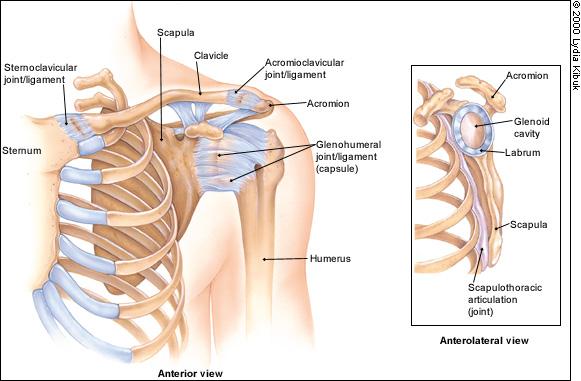Several bones and soft tissues make up the shoulder, including the scapula, acromion, humerus, and glenoid. The glenohumeral, acromioclavicular, and scapulothoracic joints make the shoulder’s articulations. In the glenohumeral joint, the glenoid labrum and the fibrous capsule are joined by a ligament. Because of a lack of bone support, the glenohumeral joint is the most often dislocated of the main joints. To maintain the stability of the glenohumeral joint, all of its components function together. The static mutual support is provided by the capsulolabral complex and the joint surfaces, whereas dynamic joint stability is provided by the rotator cuff muscles and the scapular rotators (Ng & Wu, 2021). Three muscles offer scapular stability: the trapezius, serratus anterior, and rhomboid. Shoulder pain is caused by rotator cuff muscular compression on the glenoid. The deltoid muscle can raise the humeral head within the joint depending on the severity of the rotator cuff injury.

The levator scapula and rhomboids work with the trapezius and serratus anterior muscles to help bring the scapula back into the head and maintain appropriate posture. As part of the evaluation process, the patient’s age, dominant hand, and sporting or occupational interests are all considered. Ask their doctor how the injury has affected their work, leisure activities, and sports. An examination by the patient’s primary care physician should focus on symptoms such as shoulder pain, stiffness, locking, catching, and swelling. It can be unpleasant to throw with anterior glenohumeral instability while pitching a baseball or engaging in similar sports. Recent studies show that glenohumeral unrest is more common in patients with severe joint laxity. Diagnosis is aided by the capacity to distinguish between an acute and a chronic condition, as shown in Figure 1 above. One should be mindful of the possibility of glenoid labral damage if one has had recent shoulder trauma involving abduction and external rotation of the arm, for example. Rotator cuff injury is another name for the frozen shoulder, characterized by persistent pain and restricted passive range of motion in the shoulder. The location, quality, content, and aggravating and relieving elements that contribute to the shoulder’s discomfort must be determined to rule out the potential of transferred pain. It is common for people to confuse neck and arm pain with a shoulder problem. Numerous medical conditions can cause shoulder pain in some people, such as pneumonia and heart failure (Shaibani, 2018). Metastatic cancer is more likely in people with a history of disease in their families. A patient’s history of corticosteroid use should be inquired if they have osteopenia or rotator cuff tendon atrophy. Provocative tests for impingement syndrome and glenohumeral instability are part of a comprehensive physical exam.
References
Ng, C. Y., & Wu, F. (2021). Scapular winging secondary to serratus anterior dysfunction: Analysis of clinical presentations and etiology in a consecutive series of 96 patients. Journal of Shoulder and Elbow Surgery, 30(10), 2336-2343.
Shaibani, A. (2018). Scapular winging. Oxford Medicine Online.
Woodward, T. W. (2020). The painful shoulder: Part I. Clinical evaluation. AAFP American Academy of Family Physicians. Web.